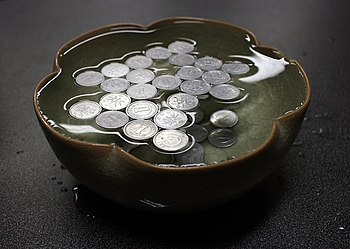Phenomena at the interface of phases
Surface tension[edit | edit source]
Inside the liquid, all the molecules are surrounded by the same molecules, and they equally exert cohesive forces on each other from all sides. At the interface of the phases (i.e. at the surface of the liquid), the liquid tries to occupy as little surface as possible due to the result of inward forces. Surface tension is the tangential force to the surface of a liquid that decreases with increasing temperature. Its unit is N/m. It can also be defined as the energy required to increase the liquid surface by 1m2. Substances dissolved in a liquid that reduce the surface tension of liquids are called surfactants'. Surface tension is important, for example, during breathing (moist alveolar walls).
Adsorption[edit | edit source]
At the phase interfaces, there is always a greater concentration of substances dissolved in the liquid, because its surface tension is thus reduced -> this process is called adsorption. diffusion acts against this process and the result is the establishment of the so-called adsorption equilibrium expressed by the Gibbs adsorption equation (isotherm).
Links[edit | edit source]
Source[edit | edit source]
- KUBATOVA, Senta. Biofot [online]. [cit. 2011-01-31]. <https://uloz.to/!CM6zAi6z/biofot-doc>.
- JIŘÍ, Beneš, – DANIEL, Jirák, – FRANTIŠEK, Vítek,. Základy lékařské fyziky. - edition. Charles University in Prague, Karolinum Press, 2015. pp. 322. ISBN 9788024626451.

